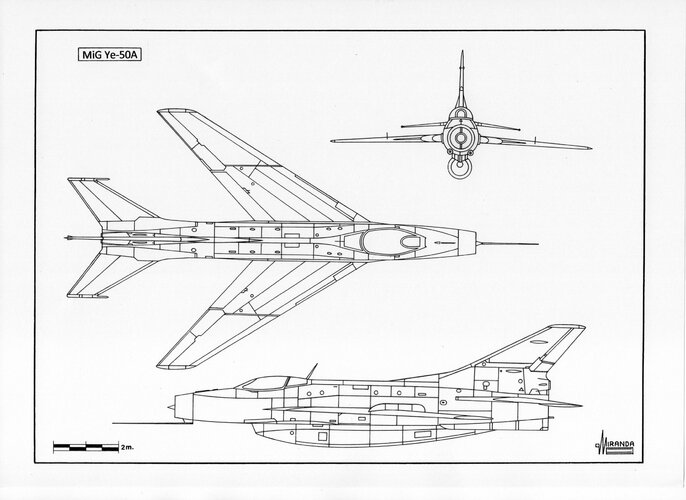In 1953 a British bomber Canberra B2 (WH726) was modified with the installation of a K-30 Perkin-Elmer camera in the bomb bay.
In August, as part of the Operation ROBIN, the plane took off from Giebelstadt-West Germany overflying Kiev, Kharkov and Stalingrad at 46,000-48,000 ft. it was attacked unsuccessfully by fifteen MiG-17 fighters.
At that time the MiG-17 F could reach 46,000 ft. in 6.3 minutes but at that altitude the Canberra was faster and the MiG could not achieve interception.
After the Canberra managed to photograph the missile test facility at Kapustin Yar, flying at 48,500 ft. it was again attacked and damaged by Soviet fighters, although it managed to land safely in Iran.
The MiG-17 F could reach 54,500 ft. (16,600 m) if he had enough time, that allowed him to intercept the Canberra over Kapustin Yar, but at that altitude the Soviet fighter could only maneuver to make a single attack.
On March 19, 1954 to counter the threat, the Council of Ministers ordered the development of a new Mach 2 clear-weather interceptor, with 65,600 ft. (20,000 m) ceiling.
The MiG bureau proposed two basic configurations, swept wing and delta wing, powered by one Tumansky turbojet type AM-9B or AM-11.
The delta wing prototype, named Ye-4 (Yedinitsa-single unit), was flown on June 16, 1955 and its development continued with the Ye-5 and Ye-6 until it reached the production phase as MiG-21.
The swept wing prototype Ye-2 flew on February 14, 1955 reaching 1,920 km/h and 62,300 ft. (19,000 m) ceiling powered by one AM-9B turbojet rated at 3,250 kg thrust with afterburner.
But these performances were considered insufficient and the project was modified as a mixed-power, short-range point defense interceptor, under the codename MiG Ye-50.
To prove the concept, three prototypes were built powered by one Tumansky AM-9 turbojet, rated at 3,800 kg with afterburner and one Dushkin S-155 bi-propellant rocket motor with 1,300 kg peak trust at sea level and 1,600 kg at high altitude.
The Ye-50/1 flew on January 9, 1956 but was damaged beyond repair in a rough landing on July 14, 1956.
The Ye-50/2 attained Mach 2.33 and 84,000 ft. (25,600 m) ceiling on June 17, 1957 and the construction of a pre-production batch of 20 aircraft was ordered, under the codename Ye-50A.
The new fighter was expected to reach 89,216 ft. (27,200 m) ceiling powered by one AM-11 turbojet and one R11E-300 rocket motor, but the project was cancelled following the destruction of the Ye-50/3 caused by the rocket explosion on August 8, 1957.
In August, as part of the Operation ROBIN, the plane took off from Giebelstadt-West Germany overflying Kiev, Kharkov and Stalingrad at 46,000-48,000 ft. it was attacked unsuccessfully by fifteen MiG-17 fighters.
At that time the MiG-17 F could reach 46,000 ft. in 6.3 minutes but at that altitude the Canberra was faster and the MiG could not achieve interception.
After the Canberra managed to photograph the missile test facility at Kapustin Yar, flying at 48,500 ft. it was again attacked and damaged by Soviet fighters, although it managed to land safely in Iran.
The MiG-17 F could reach 54,500 ft. (16,600 m) if he had enough time, that allowed him to intercept the Canberra over Kapustin Yar, but at that altitude the Soviet fighter could only maneuver to make a single attack.
On March 19, 1954 to counter the threat, the Council of Ministers ordered the development of a new Mach 2 clear-weather interceptor, with 65,600 ft. (20,000 m) ceiling.
The MiG bureau proposed two basic configurations, swept wing and delta wing, powered by one Tumansky turbojet type AM-9B or AM-11.
The delta wing prototype, named Ye-4 (Yedinitsa-single unit), was flown on June 16, 1955 and its development continued with the Ye-5 and Ye-6 until it reached the production phase as MiG-21.
The swept wing prototype Ye-2 flew on February 14, 1955 reaching 1,920 km/h and 62,300 ft. (19,000 m) ceiling powered by one AM-9B turbojet rated at 3,250 kg thrust with afterburner.
But these performances were considered insufficient and the project was modified as a mixed-power, short-range point defense interceptor, under the codename MiG Ye-50.
To prove the concept, three prototypes were built powered by one Tumansky AM-9 turbojet, rated at 3,800 kg with afterburner and one Dushkin S-155 bi-propellant rocket motor with 1,300 kg peak trust at sea level and 1,600 kg at high altitude.
The Ye-50/1 flew on January 9, 1956 but was damaged beyond repair in a rough landing on July 14, 1956.
The Ye-50/2 attained Mach 2.33 and 84,000 ft. (25,600 m) ceiling on June 17, 1957 and the construction of a pre-production batch of 20 aircraft was ordered, under the codename Ye-50A.
The new fighter was expected to reach 89,216 ft. (27,200 m) ceiling powered by one AM-11 turbojet and one R11E-300 rocket motor, but the project was cancelled following the destruction of the Ye-50/3 caused by the rocket explosion on August 8, 1957.

